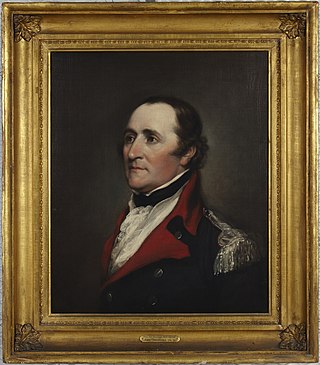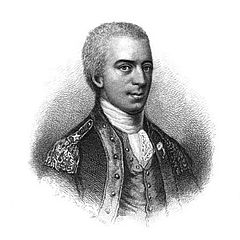The 16th Massachusetts Regiment, also known as Henry Jackson's Additional Continental Regiment, was a unit of the American Massachusetts Line, raised on January 12, 1777, under Colonel Henry Jackson at Boston, Massachusetts. The regiment would see action at the Battle of Monmouth and the Battle of Rhode Island. The regiment was disbanded on January 1, 1781, at New Windsor, New York.

The 1st Rhode Island Regiment was a regiment in the Continental Army raised in Rhode Island during the American Revolutionary War (1775–83). It was one of the few units in the Continental Army to serve through the entire war, from the siege of Boston to the disbanding of the Continental Army on November 3, 1783.

The 2nd Rhode Island Regiment was authorized on 6 May 1775 under Colonel Daniel Hitchcock in the Rhode Island Army of Observation and was organized on 8 May 1775 as eight companies of volunteers from Providence County of the colony of Rhode Island. As part of a brigade organized under Nathanael Greene, the unit participated in the Siege of Boston during the remainder of 1775. Some elements accompanied Benedict Arnold's expedition to Quebec late in the year. The unit was renamed the 11th Continental Regiment on the first day 1776.
The 6th Connecticut Regiment was raised on May 1, 1775, at New Haven, Connecticut, as a provincial regiment for the Continental Army. It then became a regiment of the Continental Line on January 1, 1776, designated the 10th Continental Regiment, and a regiment of the Connecticut Line on January 1, 1777, again designated the 6th Connecticut. The regiment saw action at the siege of Boston, the Battle of Long Island, the New York Campaign, and its colonel and company of light infantry served in the Corps of Light Infantry at the Battle of Stony Point. The regiment was merged into the 1st Connecticut Regiment on January 1, 1783, at West Point, New York and disbanded on November 16, 1783.

The 2nd Canadian Regiment (1776–1783), also known as Congress' Own or Hazen's Regiment, was authorized on January 20, 1776, as an Extra Continental regiment and raised in the province of Quebec for service with the American Continental Army under the command of Colonel Moses Hazen. All or part of the regiment saw action at Staten Island, Brandywine, Germantown and the Siege of Yorktown. Most of its non-combat time was spent in and around New York City as part of the forces monitoring the British forces occupying that city. The regiment was disbanded on November 15, 1783, at West Point, New York.
The 2nd New Jersey Regiment was raised, on 9 October 1775, at Trenton, New Jersey, for service with the Continental Army under the command of Colonel William Maxwell. The regiment would see action at the Battle of Trois-Rivières, Battle of Valcour Island, Battle of Brandywine, Battle of Germantown, Battle of Crooked Billet, Battle of Monmouth, Sullivan Expedition, Battle of Springfield and the Battle of Yorktown. The regiment was furloughed, on 6 June 1783, at Newburgh, New York, and disbanded 3 November 1783.
The 6th Pennsylvania Regiment, first known as the 5th Pennsylvania Battalion, was a unit of the United States of America (U.S.) Army, raised December 9, 1775, at Philadelphia, Pennsylvania, for service with the Continental Army. The regiment would see action during the New York Campaign, Battle of Brandywine, Battle of Germantown, Battle of Monmouth, and Green Spring. The regiment was disbanded on January 1, 1783.

The Connecticut Line was a formation within the Continental Army. The term "Connecticut Line" referred to the quota of numbered infantry regiments assigned to Connecticut at various times by the Continental Congress, the size of its allocation determined by the size of its population relative to that of other states. These, together with similarly apportioned contingents from the other twelve states, formed the Continental Line. The concept was particularly important in relation to the promotion of commissioned officers. Officers of the Continental Army below the rank of brigadier general were ordinarily ineligible for promotion except in the line of their own state.

The Massachusetts Line was those units within the Continental Army that were assigned to Massachusetts at various times by the Continental Congress during the American Revolutionary War. These, together with similar contingents from the other twelve states, formed the Continental Line. Line regiments were assigned to a particular state, which was then financially responsible for the maintenance of the regiment. The concept of the line was also particularly important in relation to the promotion of commissioned officers. Officers of the Continental Army below the rank of brigadier general were ordinarily ineligible for promotion except in the line of their own state.

The New Hampshire Line was a formation in the Continental Army. The term "New Hampshire Line" referred to the quota of numbered infantry regiments assigned to New Hampshire at various times by the Continental Congress. These, along with similar contingents from the other twelve states, formed the Continental Line. For the promotion of senior officials, this concept is particularly important. Officers of the Continental Army below the rank of brigadier general were ordinarily ineligible for promotion except in the line of their own state.

Ebenezer Huntington was an officer in the Continental Army during the American Revolutionary War, and afterwards United States Representative from Connecticut.
Washington's aides-de-camp during the American Revolutionary War were officers of the Continental Army appointed to serve on General George Washington's headquarters staff, with the rank of lieutenant colonel. The headquarters staff also included one military secretary, a full colonel.
Jeremiah Olney was born into an old family from Rhode Island. He formed a company of infantry from that state at the start of the American Revolutionary War. After serving as captain in 1776, he was promoted to lieutenant colonel at the beginning of 1777. As second-in-command of the 2nd Rhode Island Regiment, he fought at Red Bank. After its commander was wounded early in the action, he led Varnum's brigade in bitter fighting at Monmouth in June 1778.
Spencer's Additional Continental Regiment, sometimes referred to as the 5th New Jersey Regiment, was an American infantry unit that served for four years in the Continental Army during the American Revolutionary War. The Continental Congress authorized sixteen "Additional" Continental Regiments in late 1776 and Colonel Oliver Spencer accepted command of this regiment with rank from January 15, 1777.

Sherburne's Additional Continental Regiment was a unit of the Continental Army which served from January 1, 1777 until it was disbanded on January 1, 1781. It was commanded by Colonel Henry Sherburne.
Colonel Henry Sherburne (1748-1824) was an officer in the Continental Army during the American Revolution. He commanded Sherburne's Additional Continental Regiment from 1777 to 1781 and served as the General Treasurer of Rhode Island from 1792 to 1807.
Babcock's/Lippitt's Regiment was a regiment raised for the defense of Rhode Island during the American Revolution.

Samuel Blachley Webb (1753–1807) was the commanding officer of the 9th Connecticut Regiment in the American Revolutionary War.







